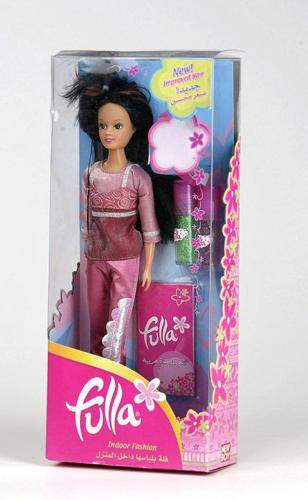By Allie Shah
McClatchy-Tribune News Service
MINNEAPOLIS — Glance at Fulla, and you feel sure she’s Barbie’s cousin.
The two dolls are the same height, with the same oval face and straight hair cascading down their backs. Even their plastic high heels are about the same size. But the similarities end there. Fulla doesn’t own a bikini, for example, and certainly not the supersized chest to fill one.
Instead Fulla, created by a toy company based in the United Arab Emirates, wears an abaya — a long, black robe — that covers her body from head to toe. Her eyes are mocha, her skin caramel, her hair jet black.
The doll, which has been outselling Barbie in the Middle East since its launch in 2003, is the latest example of a new crop of dolls reflecting different races, values, religions and cultures. Fulla will appear at the 2007 Toy Fair in New York City in February. Other doll companies, such as American Girl and Dolls Like Me, also have introduced ethnic dolls, including African-American, Hispanic, Native American and Asian options.
Named after a fragrant flower, the Fulla line includes a variety of dolls dressed in clothes that reflect different countries in the Middle East and Asia. But Fulla goes beyond the external fashion and beauty focus. She is a doctor and teacher who respects her parents and likes to read and play sports.
“The message that Fulla brings ... is promoting good virtues for little girls,” said Basel Kanawati, chief technology officer for NewBoy, the company that created Fulla. “It’s asking girls to take pride in themselves and not dress for boys and be the sex symbols that other dolls tend to be.”
Kanawati, who lives in Charlotte, N.C., said the doll fills a void for parents and girls who want a doll that looks like them and represents their values. The father of four daughters said he sees the pressures girls face. “They feel they need to imitate other people to be accepted into society. The message (of Fulla) is (that) you can be proud of yourself and function in society.”
But is it fun?
Although some versions of Fulla include a pink felt prayer mat and abaya, she is not a “Muslim doll,” Kanawati said. He calls her a “global doll,” because she wears a variety of clothes from different parts of the world. There are Fulla dolls with saris, sold in India, for example, and dolls with Malaysian clothes sold in Malaysia.
Christine Williams, professor of sociology at the University of Texas at Austin, says that while adults fret over the potential hazards of their children playing with dolls that don’t resemble them, kids generally just see dolls as toys.
“I think parents project an awful lot of power onto these objects, that may or may not have any true impact on what the child will do. The question of what children do with Barbies or their toys has always been up in the air.”
When Barbie was first introduced in 1959, she caused a stir among many mothers offended by her sensuous shape, said Williams, author of “Inside Toyland: Working, Shopping and Social Inequality” (University of California Press, 2006). Later, some feminist groups also found fault with Barbie, saying the doll promoted an unrealistic body image for girls.
In the 1960s and 1970s, another controversy ensued, this time over the dearth of African-American dolls. The first black dolls came onto the market, resembling Barbie and produced by a black-owned company. Mattel followed later with a black doll that was Barbie’s friend.
“This idea of all groups needing representation has been around,” Williams said. “Part of getting respect is to see yourself in the mainstream. The problem is that it can become a superficial representation.” For example, she said, “culture (sometimes) gets translated in exotic dress or olive-colored skin,” without a real appreciation of the culture’s history, values and norms.
Dollmakers also have long grappled with how to create dolls with accurate body parts that are still appropriate for children. One Fulla doll wears a pink jumpsuit that covers most of her arms and legs. Beneath her clothes, though, a pink tank top and pants are painted on her upper and lower torso.
Williams said that the painted-on clothes solution was also used to protect modesty when the Ken doll was designed. At the time, there was a debate over whether he should have a bulge in his pants; the manufacturer painted underpants onto his torso.
“There was this concern that it can’t be nude,” she said, “and children pick up on that: Why is this part of the doll not undressable?” Williams suggested that adults who design female dolls without breasts are showing their extreme ambivalence about femininity. “On the one hand, the idea is trying to provide a role model for children to emulate. On the other hand, they’re showing their discomfort with anything sexual.”
Dolls, she said, can become a flash point for unresolved cultural values. “They really do come to represent contradictions we have over women’s roles in society,” she said.
Children, however, will judge them based on what kind of value they bring as a plaything. “They just think it’s fun or it’s not,” Williams said. “That will be the real test, whether this is something that only adults will collect or whether (it’s something) kids will want.”

The Fulla doll in sales box.










